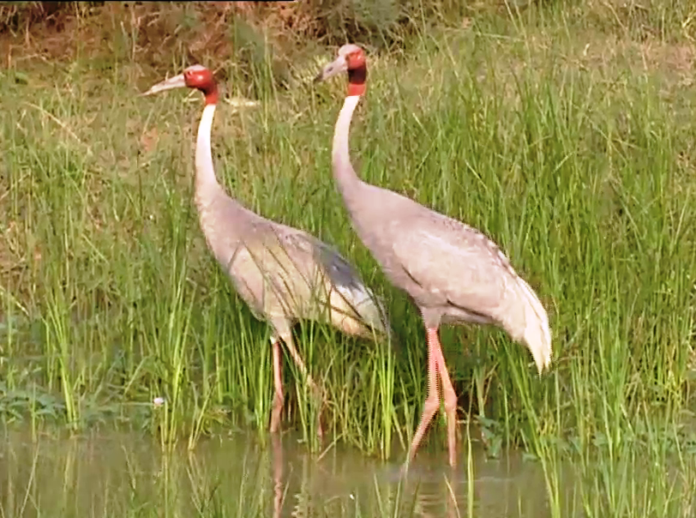Sarus Crane or Grus antigone
Sarus Crane or Grus antigone, standing almost 150 cms high, is the tallest flying bird in the world with a wing span of about 2.4 meters. With a predominantly grey plumage, a red head (which brightens up in the mating season) and pale red legs, it weighs about 6.8 to 7.8 kgs. It is a social bird living in pairs or in small groups of 3 to 4 mainly in wetlands and sometimes in cultivated areas. Breeding is inland but always in a wet area. When nesting, Sarus cranes can be very protective and are aggressive towards intruders. It is known to live for 15 to 20 years in the wild and about 40 years in captivity.
It is possessively monogamous and is known to mate for life. Exceptions have however, also been reported and they may choose to live alone or replace a mate. Nests are built on water in Natural wetlands or in flooded paddy fields. A clutch may have two to three eggs which are usually incubaded by both the parents for 26 to 35 days. The juveniles follow their parents from the day they are born. The Red legs of the parent are an important guiding tool.
They are active during the day and sleep at night. Sarus cranes are known to dance to attract mates. These dances could be accompanied by loud trumpeting. They are semi aquatic, wading, non migratory birds which may often soar high in the skies.
The Sarus is omnivorous and feeds on a wide range of food such as aquatic plants, seeds, grains, rice, crustaceans, snails, large insects such as grass hoppers, amphibians, reptiles, small vertebrates and fish.
The Sarus crane has an estimated global population of 25000 to 37000 (19000 to 21000 as per IUCN) individuals distributed in the Indian subcontinent, South East Asia and Northern Australia. In South East Asia it is now confined to Vetnam and Cambodia with a small population in Myanmar. The Australian sarus crane lives in North Australia. In the Indian subcontinent it is found in Northern and Central India, Terai Nepal and Pakistan. The population in India is now on the decline with only 15000 to 20000 birds, a majorly of which (about 13000) are reported from Uttar Pradesh. Conservation issues range from habitat loss, loss of wetlands including conversion of wetlands to agriculture, consequent dangers due to ingestion of pesticide residues and accidents due to collision with high tension wires. The Bird is listed in Schedule IV of the Wild Life (Protection) Act 1972 and as a Vulnerable on IUCN Red List.
©Srimaa Communication
Credits : Dr. Yashpal Singh, Mrs. Neena Singh, Mr. Rajesh Bedi, Manoj Kumar Yadav
